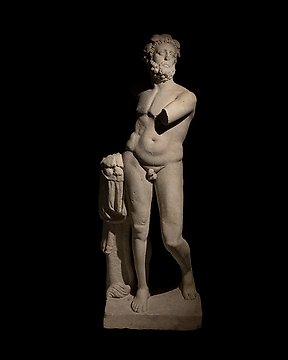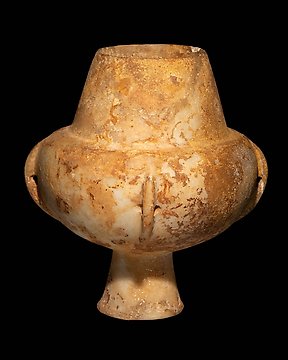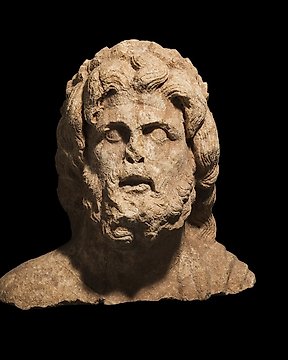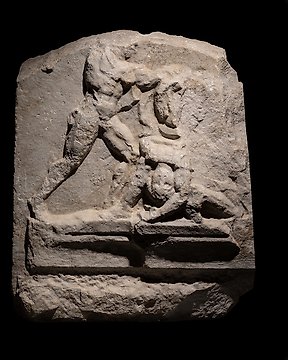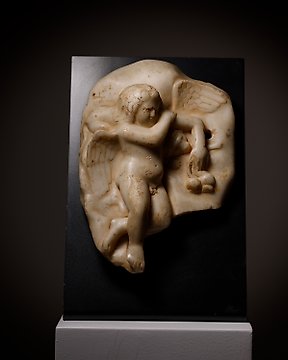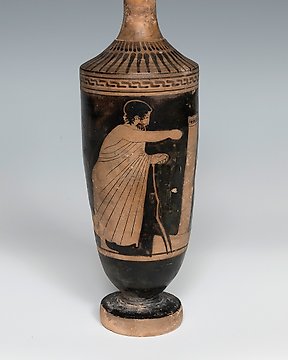Herzlichen Dank!
Übersetzung ansehenAltrömisch, Kaiserreich Marmor Schönes Relief mit Dmanatio ad Bestias. 42 cm L. 1. - 2. Jahrhundert n. Chr. Spanische Exportlizenz.
Nr. 84870815
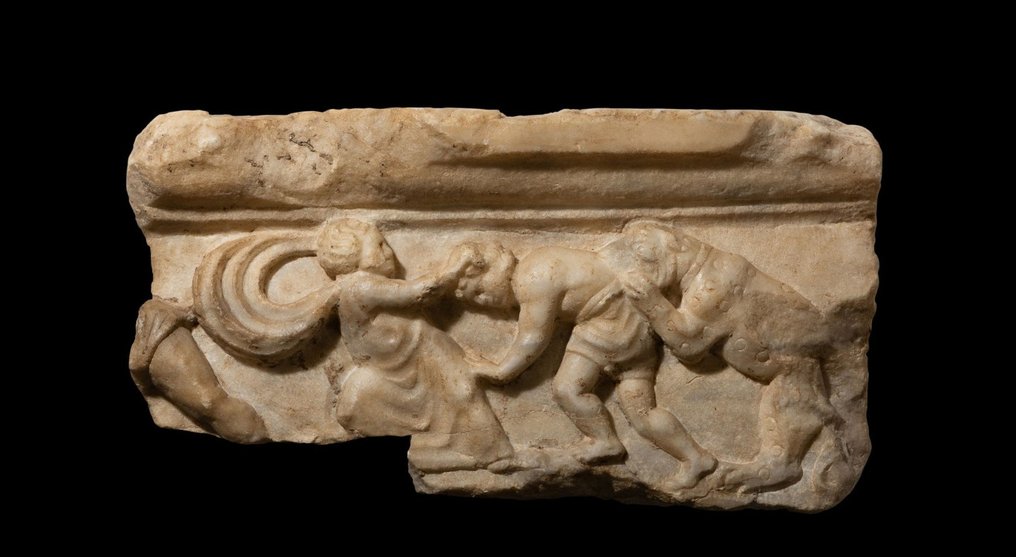

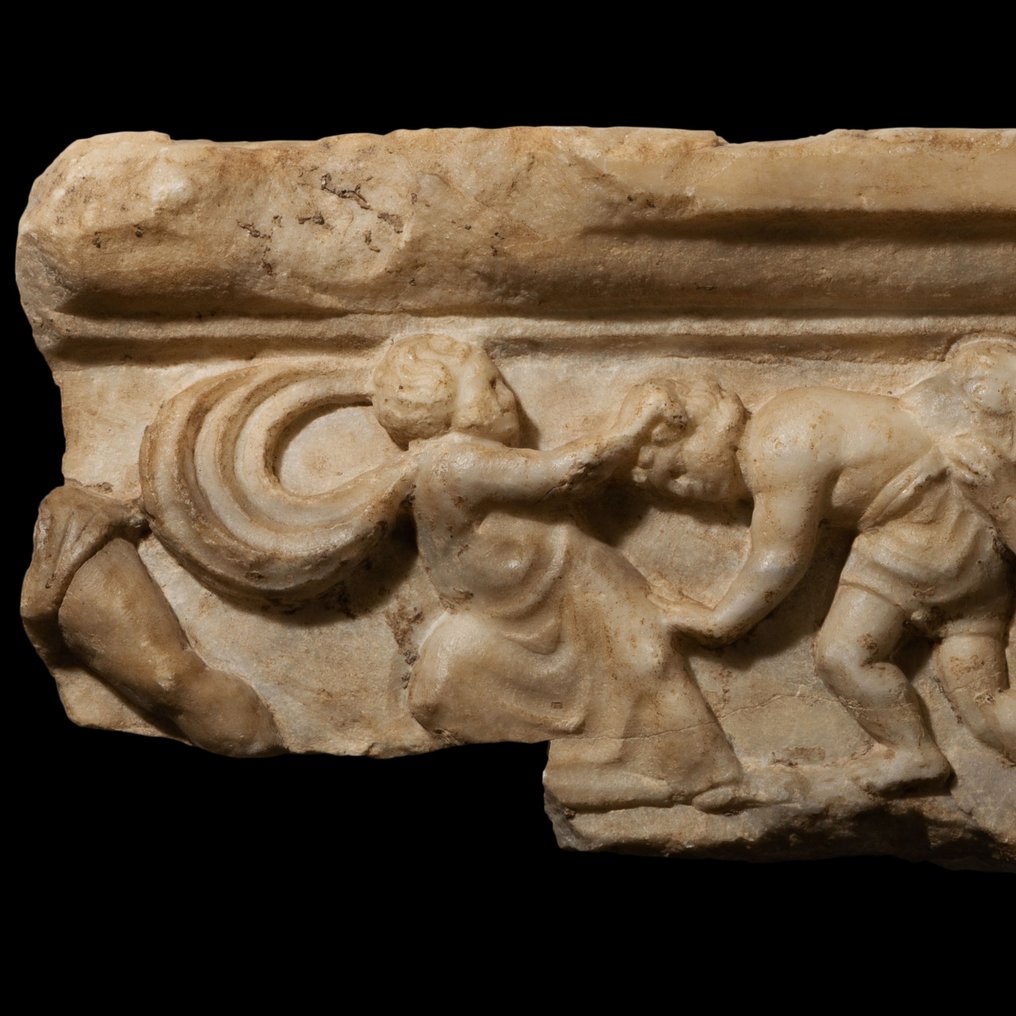
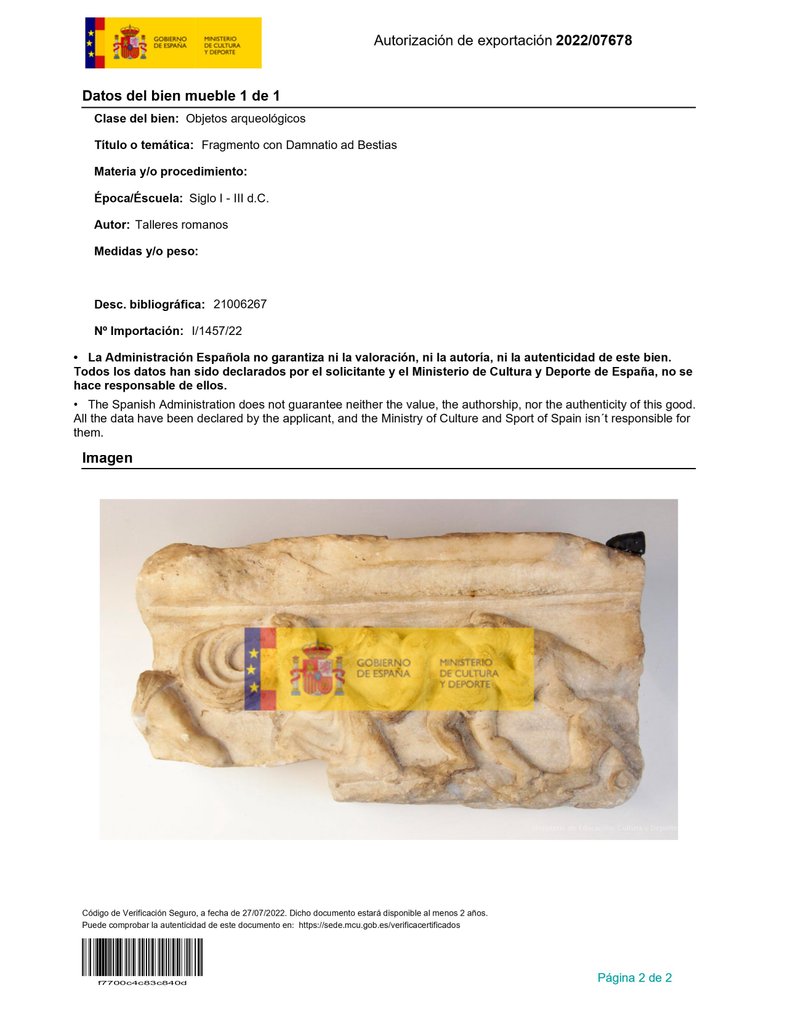
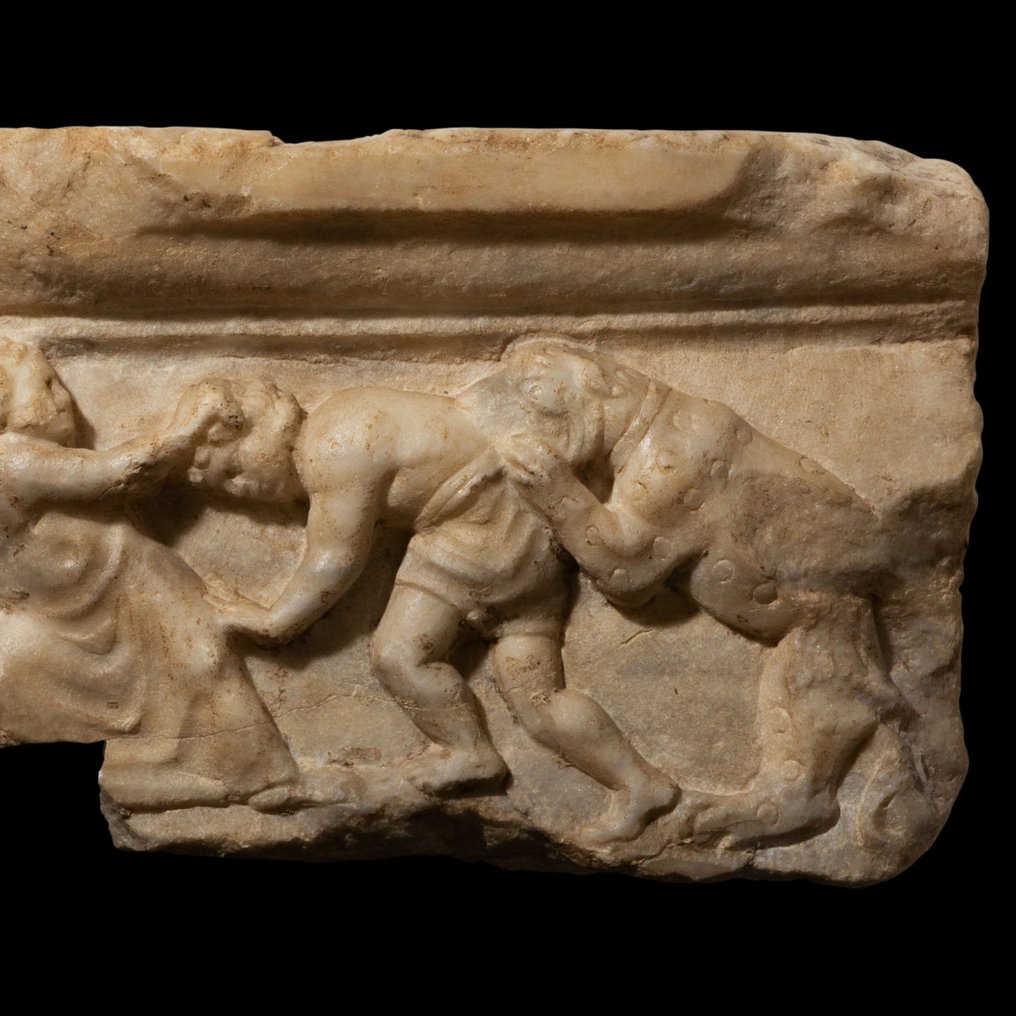
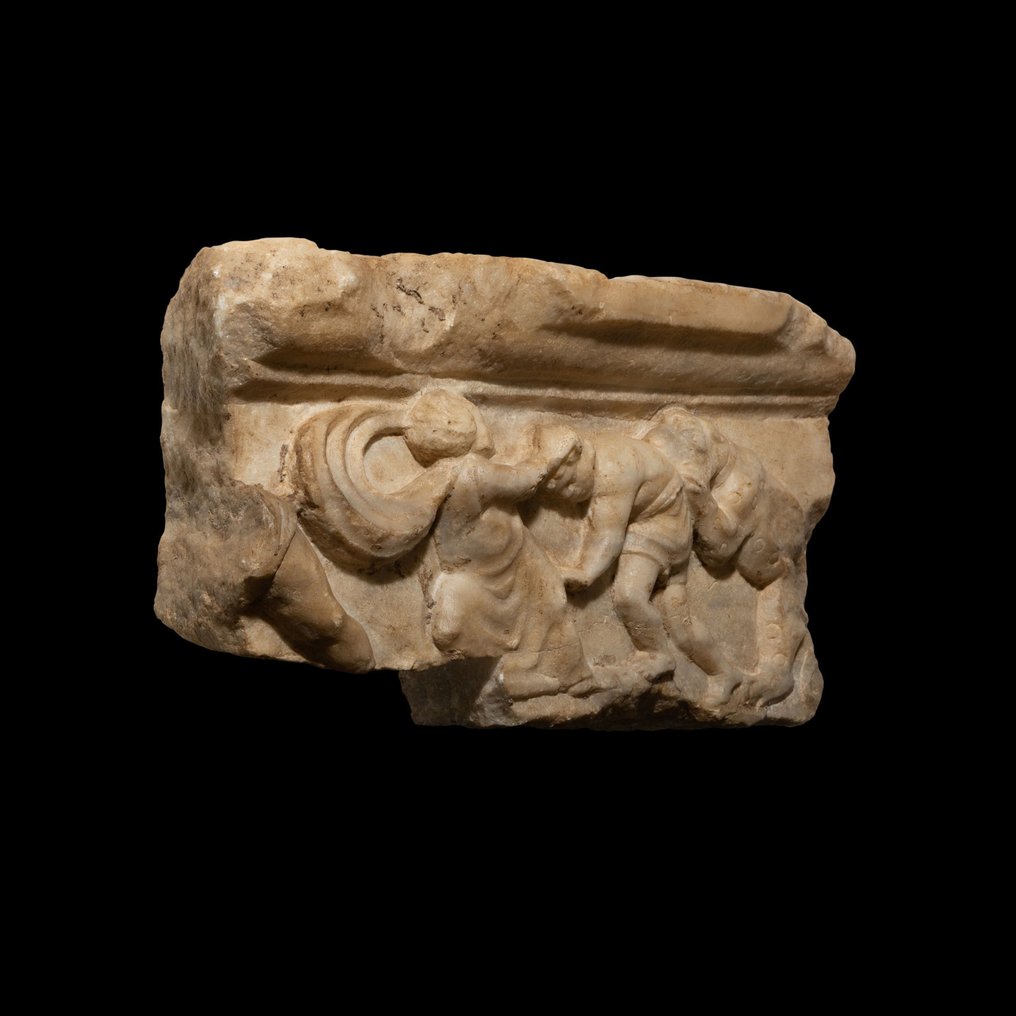
FRAGMENT WITH DAMNATIO AD BESTIAS
Ancient Rome · 1st - 2nd century AD
Marble.
Length 42 cm Height 21.5 cm without stand.
Museum metal stand included.
Condition: Fragment without restorations, in good condition.
Provenance:
- Private collection of Alison Barker (1951-2021), Chichester, UK.
Roman sculptural fragment carved in marble in relief on two planes. It presents, in a continuous composition in the form of a frieze, three interrelated figures: a tiger and two men. The beast appears raised on its hind legs, to the left, with its claws and jaws nailed to the back of one of the men. This one, about to die, bows to the second character, who appears standing before him, resting his right hand on the victim's head. The three figures are represented in strict profile, although this does not detract from the naturalism of the scene, whose dynamism is accentuated by the figures leaning to the left: the tiger supports its weight on its victim, and the latter on what appears to be its savior. who, although also leaning back, draws his left leg back to settle on the ground, restraining the movement of the other two figures. This is how the sculptor highlights, compositionally, the key role of this second figure, who is also highlighted by the richness of his clothes: while the attacked man wears a short tunic, the upright character wears a toga and a wide mantle that, swollen by the wind forms a great arc behind him. At the extreme left of the composition you can see part of a third figure, a bare leg, extended in full movement.
Due to its format, narrow and elongated with a flat linteled area in the upper part, it can be deduced that this relief would originally belong to the sculptural decoration of a sarcophagus. It would be part of a longer continuous frieze, a common element in the ornamental composition of Roman sarcophagi.
Regarding the theme represented, it is a scene from what is known as damnatio ad bestias, a type of death penalty that consisted of throwing the condemned man to wild beasts. This punishment could be carried out in different ways, but it usually took place in the circus arena. The custom, of Eastern origin, was imported to Rome not only as a punishment for criminals, but also, and at the same time, as a show. The preferred beasts were the big cats, especially the tiger, although throughout its centuries of development other wild animals such as the bear, the boar, the elephant or the rhinoceros were also used. Brought from Carthage by the victorious commanders of the Macedonians in 167 BC, the damnatio ad bestias was originally a punishment intended only for enemy soldiers accused of treason or desertion, who were tied to a post and left defenseless against animals. wild. Over time, given the love of the Roman people to contemplate these punishments, the damnatio ad bestias became a show of considerable complexity, with even theatrical overtones.
The condemned could be placed in a cage full of beasts, or in the circus arena, tied up and defenseless. Sometimes, however, they were provided with weapons to make the spectacle more interesting, and these executions were even conceived as fantastic battles between men and animals: Pompey, during his second consulship (55 AD), organized a fight between gladiators strongly armed and eighteen elephants. The success of the show was such that a few decades later, in the 1980s, it was part of the inaugural games at the Flavio amphitheater.
Although there were emperors, such as Caligula, who used this death penalty for all kinds of criminals indiscriminately, the Roman penal code dictated that the damnatio ad bestias was reserved for deserters from the army, those who used magic to harm others , poisoners, counterfeiters, political criminals, parricides, instigators of popular uprisings and child kidnappers. In addition, between the 1st and 3rd centuries it was also used as a punishment for escaped and Christian slaves. Proof of how popular this punishment was is the fact that the Lex Petronia, in the year 61, specifically prohibited citizens from throwing their slaves to wild beasts without prior trial. The practice was finally abolished in Rome in 681, though with one exception: in 1022, already in Byzantine times, a royal eunuch who had conspired against the emperor was thrown to the lions.
Despite what can be seen in the relief under study, the damnatio ad bestias was not a punishment that contemplated the possibility of forgiveness. It was the most humiliating way to die, and at the same time an expensive and complex show to organize. There was therefore no possibility of going back. This allows us to think that, in the case of this relief, some kind of mythical scene is being represented. In fact, in the damnatio ad bestias it was common for the punishment to be staged as if it were a mythological story. Martial describes, for example, the death of a condemned man who, presented to the public as Orpheus, is torn to pieces by a bear on a stage decorated with trees, evoking the Garden of the Hesperides. in all In any case, the punishments-show were in Rome a clear expression of the power of the rulers, and this is precisely what is reflected in the relief under study: there is a dignified character (position, clothes, attitude) in whose hands the power rests about the life and death of the convicted person who, having broken the law, has lost all his rights, and any kind of control over his life. It is possible, therefore, a symbolic, moralizing reading of the scene, which tells us about the "just" punishment that awaits those who do not respect the common law.
Notes:
- The piece includes authenticity certificate.
- The piece includes Spanish Export License (Passport for European Union) - If the piece is destined outside the European Union a substitution of the export permit should be requested, can take between 1-2 weeks maximum.
- The seller guarantees that he acquired this piece according to all national and international laws related to the ownership of cultural property. Provenance statement seen by Catawiki.
Der Verkäufer stellt sich vor
FRAGMENT WITH DAMNATIO AD BESTIAS
Ancient Rome · 1st - 2nd century AD
Marble.
Length 42 cm Height 21.5 cm without stand.
Museum metal stand included.
Condition: Fragment without restorations, in good condition.
Provenance:
- Private collection of Alison Barker (1951-2021), Chichester, UK.
Roman sculptural fragment carved in marble in relief on two planes. It presents, in a continuous composition in the form of a frieze, three interrelated figures: a tiger and two men. The beast appears raised on its hind legs, to the left, with its claws and jaws nailed to the back of one of the men. This one, about to die, bows to the second character, who appears standing before him, resting his right hand on the victim's head. The three figures are represented in strict profile, although this does not detract from the naturalism of the scene, whose dynamism is accentuated by the figures leaning to the left: the tiger supports its weight on its victim, and the latter on what appears to be its savior. who, although also leaning back, draws his left leg back to settle on the ground, restraining the movement of the other two figures. This is how the sculptor highlights, compositionally, the key role of this second figure, who is also highlighted by the richness of his clothes: while the attacked man wears a short tunic, the upright character wears a toga and a wide mantle that, swollen by the wind forms a great arc behind him. At the extreme left of the composition you can see part of a third figure, a bare leg, extended in full movement.
Due to its format, narrow and elongated with a flat linteled area in the upper part, it can be deduced that this relief would originally belong to the sculptural decoration of a sarcophagus. It would be part of a longer continuous frieze, a common element in the ornamental composition of Roman sarcophagi.
Regarding the theme represented, it is a scene from what is known as damnatio ad bestias, a type of death penalty that consisted of throwing the condemned man to wild beasts. This punishment could be carried out in different ways, but it usually took place in the circus arena. The custom, of Eastern origin, was imported to Rome not only as a punishment for criminals, but also, and at the same time, as a show. The preferred beasts were the big cats, especially the tiger, although throughout its centuries of development other wild animals such as the bear, the boar, the elephant or the rhinoceros were also used. Brought from Carthage by the victorious commanders of the Macedonians in 167 BC, the damnatio ad bestias was originally a punishment intended only for enemy soldiers accused of treason or desertion, who were tied to a post and left defenseless against animals. wild. Over time, given the love of the Roman people to contemplate these punishments, the damnatio ad bestias became a show of considerable complexity, with even theatrical overtones.
The condemned could be placed in a cage full of beasts, or in the circus arena, tied up and defenseless. Sometimes, however, they were provided with weapons to make the spectacle more interesting, and these executions were even conceived as fantastic battles between men and animals: Pompey, during his second consulship (55 AD), organized a fight between gladiators strongly armed and eighteen elephants. The success of the show was such that a few decades later, in the 1980s, it was part of the inaugural games at the Flavio amphitheater.
Although there were emperors, such as Caligula, who used this death penalty for all kinds of criminals indiscriminately, the Roman penal code dictated that the damnatio ad bestias was reserved for deserters from the army, those who used magic to harm others , poisoners, counterfeiters, political criminals, parricides, instigators of popular uprisings and child kidnappers. In addition, between the 1st and 3rd centuries it was also used as a punishment for escaped and Christian slaves. Proof of how popular this punishment was is the fact that the Lex Petronia, in the year 61, specifically prohibited citizens from throwing their slaves to wild beasts without prior trial. The practice was finally abolished in Rome in 681, though with one exception: in 1022, already in Byzantine times, a royal eunuch who had conspired against the emperor was thrown to the lions.
Despite what can be seen in the relief under study, the damnatio ad bestias was not a punishment that contemplated the possibility of forgiveness. It was the most humiliating way to die, and at the same time an expensive and complex show to organize. There was therefore no possibility of going back. This allows us to think that, in the case of this relief, some kind of mythical scene is being represented. In fact, in the damnatio ad bestias it was common for the punishment to be staged as if it were a mythological story. Martial describes, for example, the death of a condemned man who, presented to the public as Orpheus, is torn to pieces by a bear on a stage decorated with trees, evoking the Garden of the Hesperides. in all In any case, the punishments-show were in Rome a clear expression of the power of the rulers, and this is precisely what is reflected in the relief under study: there is a dignified character (position, clothes, attitude) in whose hands the power rests about the life and death of the convicted person who, having broken the law, has lost all his rights, and any kind of control over his life. It is possible, therefore, a symbolic, moralizing reading of the scene, which tells us about the "just" punishment that awaits those who do not respect the common law.
Notes:
- The piece includes authenticity certificate.
- The piece includes Spanish Export License (Passport for European Union) - If the piece is destined outside the European Union a substitution of the export permit should be requested, can take between 1-2 weeks maximum.
- The seller guarantees that he acquired this piece according to all national and international laws related to the ownership of cultural property. Provenance statement seen by Catawiki.
Der Verkäufer stellt sich vor
- 747
- 6
- 0
All OK and with very fast shipping.
Übersetzung ansehenPrachtig schilderij. Zo blij mee. Zeer nette verkoper en zeer snelle levering.
Übersetzung ansehenperfect ! very fast and high quality delivery !
Übersetzung ansehenAll well! Thanks.
Übersetzung ansehenVendeur très professionnel, top +++×
Übersetzung ansehenPhotos trop contrastées pour bien percevoir les défauts, mais ces défauts étaient visibles pour autant. Le "Bon état" est trompeur. Sinon, envoi rapide et correctement emballé. Frais de port exagérés.
Übersetzung ansehenGreat communication, delivery and product. Came with a well made certificate of authenticity and good packaging. Overall very happy with the purchase! Delivery is a bit expensive, but I recommend it
Übersetzung ansehenMagnifique témoin du passé, envoyé avec tous les justificatifs, impeccable. Encore une fois très satisfait, un grand merci
Übersetzung ansehenThank you for the Special offer and the fast shipping of this excellent piece of art!
Übersetzung ansehenvery good description of the object, very good price for this rare item,. Fast sending (has been at my place 2 days after buying!). Definitely would buy again.
Übersetzung ansehenSehr schön
Übersetzung ansehenAs described, perfect logistic
Übersetzung ansehengreat seller, everything came as should with certificate of authenticity
Übersetzung ansehenExceptionally well packaged, description aligned with positing received
Übersetzung ansehenReally precious, but without sound...
Übersetzung ansehenPainting well packed and rapidly sent!
Übersetzung ansehensempre grande rapidità e professionalità
Übersetzung ansehenparfait bien reçu, merci
Übersetzung ansehenVery satisfied with the small Greek Lekythos. As always (we have already bought several items from Bagot), the object was wrapped and sent immediately and with the greatest care.
Übersetzung ansehenPerfect, excellent condition, good packaging, the parcel arrived without any problems… all is perfect as usual. Thank you very much and wait for an other nice piece like this one. Gilles.
Übersetzung ansehen+++ Top vendeur professionnel comme d'habitude
Übersetzung ansehenEmbora o custo de transporte esteja acima da média foi, realmente, muito bem executado e em embalagem cuidada. Expeditos e profissionais. Recomendo
Übersetzung ansehenSnel en correct en goed verpakt verzonden
Übersetzung ansehenoggetto bellissimo, fedele alla descrizione, venditore affidabile
Übersetzung ansehen

